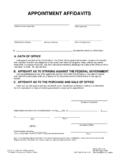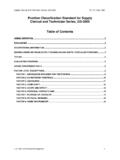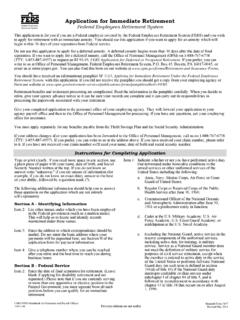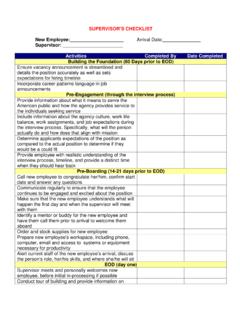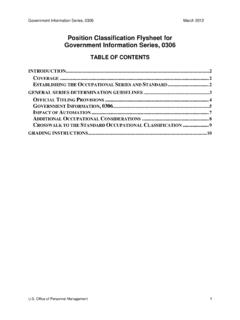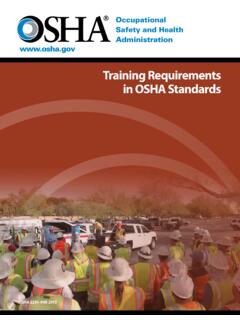Transcription of Federal Wage System Job Grading Standard for Motor Vehicle ...
1 Motor Vehicle Operating, 5703 TS-61 April 1991. Federal Wage System Job Grading Standard for Motor Vehicle Operating, 5703. Table of Contents WORK COVERED .. 2. WORK NOT 2. TITLES .. 2. GRADE LEVELS .. 2. NOTES TO 3. Motor Vehicle operator , GRADE 4. Motor Vehicle operator , GRADE 5. Motor Vehicle operator , GRADE 6. Motor Vehicle operator , GRADE 8. Motor Vehicle operator , GRADE 11. Office of Personnel Management 1. Motor Vehicle Operating, 5703 TS-61 April 1991. WORK COVERED. This Standard covers nonsupervisory work involved in the operation of gasoline, diesel, or electric powered wheeled vehicles to haul cargo and fuel, transport passengers, or to tow or recover equipment. The vehicles are driven in restricted traffic environments on Government installations, over public roads and highways, or under cross-country conditions. Also included are Motor vehicles which have special-purpose or auxiliary devices where a knowledge of such devices does not exceed the level of knowledge and skill required to operate the Vehicle safely.
2 WORK NOT COVERED. This Standard does not cover work which primarily involves: - Operating electric, diesel, or gasoline powered fork lift trucks to move, stack, and load materials in and about warehouses, storage areas, loading docks, and vehicles. (See Job Grading Standard for Fork Lift Operating Series, 5704.). - Operating wheeled tractors and attached or towed equipment such as trailers, towbars, plows, harrows, planters, mowers, post hole diggers, combines, bailers, spreaders, backhoes, and front-end loaders in order to transport materials and equipment, dig, load, plant, harvest, clear, mow, and dispense liquid and solid materials. (See Job Grading Standard for Tractor Operating Series, 5705.). - Operating gasoline or diesel powered engineering and construction equipment with wheeled or crawler-type traction such as graders, tractors with bulldozer or angledozer blades, front-end loaders, trench diggers, and large industrial tractors with pan or scraper attachments in order to cut, move, dig, grade and roll earth, sand, stone, and other materials, and to maintain ditches, road shoulders and beds, and firelines.
3 (See Job Grading Standard for Engineering Equipment Operating Series, 5716.). TITLES. Jobs covered by this Standard are to be titled Motor Vehicle operator . GRADE LEVELS. This Standard does not describe all possible grades at which jobs might be established. If jobs differ substantially from the skill, knowledge, or other work requirements described for the grade levels in the Standard , they may be graded above or below the levels described based on sound job Grading methods. Office of Personnel Management 2. Motor Vehicle Operating, 5703 TS-61 April 1991. NOTES TO USERS. An underlying premise in the grade level descriptions in this Standard , except at the grade 4 level, is that the vehicles are driven on Government installations and on public roads in a full range of traffic conditions or in installation environments that exhibit the same driving characteristics as public roads on a regular and recurring basis. Such public road characteristics would include widely dispersed urban and rural roadway systems; two-lane and four-lane highways; various weight limits and Vehicle prohibitions on certain roads or bridges; a range of driving speeds as well as highway speed limits on some roads; various traffic signals and multiple types of intersections.
4 Frequently heavy traffic congestion; and sharp curves and blind or steep hills. Situations within the confines of an installation, such as driving in congested industrial areas, impose skill and knowledge requirements on Motor Vehicle operators similar to the demands of driving on public roads in all kinds of traffic. The requirement that vehicles are operated on public roads or the equivalent in terms of driving characteristics is consistent with the key ranking job descriptions for Truck Driver (Light), Truck Driver (Medium), Truck Driver (Heavy) and Truck Driver (Trailer). set forth in Part I, Appendix 2 of the Job Grading System for Trades and Labor Occupations. In instances where drivers do not use their vehicles on public roads (or the equivalent), a lower grade level than the one depicted in this Standard for the type of Vehicle driven is appropriate. This is primarily because the knowledge and skill required for the driver to operate the Vehicle competently and safely is not as high.
5 Formerly, indicators such as gross Vehicle weight (weight of the Vehicle plus weight of the load), load capacity, number of forward speeds, number of driving ( powered ) wheels, and passenger capacity have been routinely used as the primary criteria for determining grade levels of Motor Vehicle operator jobs. These indicators are insufficient for determining the grade of the total job since they do not give consideration to all features of the job which affect the four grade determining factors of skill and knowledge, responsibility, physical effort, and working conditions involved in performing the work. However, gross Vehicle weight provides a frame of reference from which to conduct a complete analysis and evaluation of a position. Therefore, gross Vehicle weight is being retained as a means of establishing a framework in grade analysis for straight-in-line vehicles, , vehicles that are unitized with the axles, power source or cab portion of the Vehicle and load carrying body all on the same chassis.
6 This indicator does not directly apply to passenger buses, passenger ambulance buses, or Motor coaches. The final grade level for all Vehicle operating positions will be based on a thorough consideration of the four Grading factors of the total job. Office of Personnel Management 3. Motor Vehicle Operating, 5703 TS-61 April 1991. Motor Vehicle operator , GRADE 4. General: Drivers at this grade level operate one or more Motor vehicles including pickup trucks, panel trucks, flatbed trucks, carryalls, sedans, crew cab pickup trucks, jeeps, and station wagons which typically have an approximate gross Vehicle weight of up to 4500 kilograms (10,000. pounds). Vehicles are driven on the basis of either specific trip assignments or regularly established schedules and Standard routes to transport personnel, supplies, materials, or equipment and tools throughout an installation or establishment under limited traffic conditions at low speeds. Drivers perform operator maintenance, such as checking fluid levels and air pressure in tires, and cleaning and washing the vehicles.
7 They may use two-way radios to receive and transmit messages. They complete trip tickets and preventive maintenance records. Skill and Knowledge: At this grade level, drivers have basic skills for manipulating the controls for starting, stopping, backing, and driving the Vehicle . They have a knowledge of the height, width, length, and weight of the Vehicle in order to operate the Vehicle safely on short runs, following limited or prescribed routes throughout a Government installation. Also, they have a knowledge of installation traffic rules and regulations, and the skill to read and understand installation maps and other locator documents for finding various buildings and facilities. The drivers load and arrange the cargo so that it does not shift or fall and damage the material. They have a knowledge of the operator 's manual for their assigned Vehicle and the skill to apply such knowledge to particular driving situations. They have the knowledge to recognize developing maintenance problems when conducting an inspection of their vehicles, and report technical problems to the supervisor.
8 Responsibility: Drivers receive instructions from the dispatcher or supervisor on the type of Vehicle to be operated, destination, cargo or passengers to be transported, purpose of the trip, deadlines to be met, and any special information. Grade 4 drivers are responsible for the comfort and safe transport of passengers and cargo throughout the installation or establishment. For example, they adhere to installation traffic rules and safe operating practices for moving vehicles;. drive carefully to avoid jolting or injuring passengers; and load or assist in loading, unloading, and arranging cargo correctly. They enforce use of seat belts when the Vehicle is in motion. They may use a two-way radio to keep the dispatcher or supervisor informed on the status of job assignments and problems encountered. The driver's work is regularly checked and evaluated for timeliness, the safe delivery of cargo or passengers, and for following instructions. Trip tickets are examined for compliance with regulations and for completeness.
9 Physical Effort: Drivers at this grade level exert light physical effort in reaching, bending, turning, or moving hands, arms, feet, and legs to operate hand and foot controls. They exert moderate physical effort in the frequent handling of objects weighing up to 18 kilograms (40. pounds), and the occasional handling of heavier objects while loading cargo, with the assistance of other workers or weight handling equipment. Office of Personnel Management 4. Motor Vehicle Operating, 5703 TS-61 April 1991. Working Conditions: Drivers work mostly outside and operate vehicles in all kinds of weather in a controlled traffic environment throughout a Government installation or establishment. Drivers are exposed to dirt and fumes, and to the possibility of cuts, bruises, and broken bones as a result of accidents while driving or from falling objects when loading and unloading the Vehicle . Motor Vehicle operator , GRADE 5. General: Drivers at this grade level operate one or more Motor vehicles including pickup trucks, panel trucks, flatbed trucks, carryalls, sedans, crew cab pickup trucks, jeeps, and station wagons which typically have an approximate gross Vehicle weight up to 4,500 kilograms (10,000 pounds).
10 Vehicles are driven on the basis of specific trip assignments or regularly established schedules over public roads (or the equivalent) at highway speeds to transport personnel, supplies, materials, or equipment and tools or to tow equipment throughout rural or urban areas. In comparison with the restricted traffic conditions at the grade 4 level, drivers at this grade operate vehicles over Federal , state, and county roads and city streets in all traffic conditions. They load and unload the vehicles by hand, sometimes receiving help from other workers. They ensure the cargo is protected from the weather and that it is properly distributed and secured to prevent damage or loss while in transit. The drivers make certain that any equipment being towed does not exceed the maximum weight allowable for the Vehicle being driven, and that it is connected to the Vehicle according to local and Federal regulations. They perform operator maintenance and wash their vehicles in compliance with established policies.

